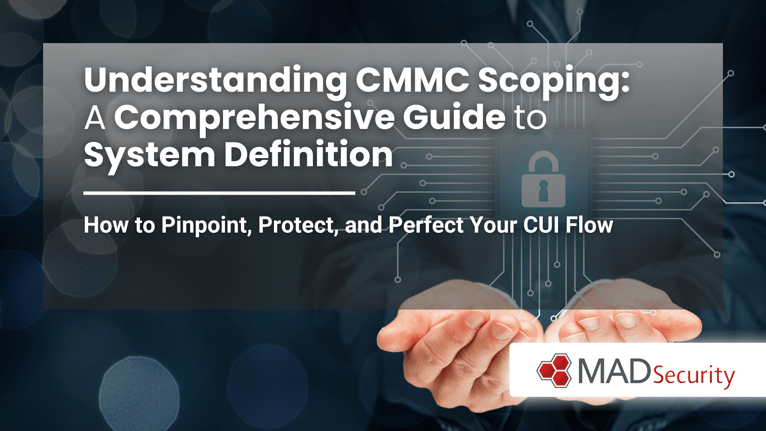
In the ever-evolving landscape of cybersecurity, the Cybersecurity Maturity Model Certification (CMMC) and DFARS 7012 have emerged as critical frameworks for safeguarding Controlled Unclassified Information (CUI). These regulatory standards are pivotal for entities engaged with the Department of Defense (DoD), ensuring that their systems are adept at securely storing, transmitting, and processing CUI.
A fundamental challenge often encountered during initial CMMC assessments is defining the precise boundaries of your “system.” This clarity is not just a compliance requirement but a cornerstone for a robust cybersecurity strategy.
However, at MAD Security, we have found that the following three simple questions can simplify this challenge and make it easier to overcome.

- How does CUI enter your system?
- Where does CUI flow in your system?
- How does CUI exit your system?
Identifying CUI Entry Points:
“How does CUI enter your system?”
Understanding how CUI enters your system is essential. This initial step involves a thorough examination of all possible entry points, which could include:
-
- Contracts and Data Exchanges: Interactions with government agencies or other contractors often involve the transfer of CUI.
- Digital Transfers: This includes direct downloads or imports from external sources.
- Manual Data Entry: User input or manual entry of data into your systems can also be a significant entry point for CUI.
Identifying these entry points is not just about compliance; it’s about fortifying the first line of defense against unauthorized access. Implementing appropriate security controls at these junctures is crucial.
Mapping the Flow of CUI:
“Where does CUI flow in your system?”
Once inside, it’s vital to track how CUI moves within your systems. This process involves identifying:
-
- Systems and Applications: Pinpoint which specific systems and applications are processing CUI.
- Data Storage: This includes all physical and cloud storage locations where CUI is kept.
- Access Control: Understanding user access levels and permissions is critical in controlling the internal movement of CUI.
- Transmission Pathways: Identify how CUI is transmitted internally, such as via email or file-sharing platforms.
Mapping the internal flow of CUI helps pinpoint potential vulnerabilities. By doing so, you can implement robust data security controls like encryption and access restriction, ensuring the integrity and confidentiality of CUI.
Monitoring CUI Exit Points:
“How does CUI exit your system?”
Equally crucial is understanding how CUI exits your system. This includes:
-
- Email Communication: Monitoring how CUI is shared via email with authorized personnel.
- Cloud and File Sharing: Keeping track of uploads to cloud storage or file-sharing platforms.
- Physical Transfers: This encompasses printing documents containing CUI or transferring data to external devices.
Identifying these exit points is integral to monitoring data movement and ensuring that CUI is shared only with authorized parties, thus preventing data leaks.
The Complexity of Answering
These Questions
While these questions might seem straightforward, their answers often delve into complex system interdependencies. The initial step in any CMMC assessment involves a guided exploration of these questions. This process not only helps in defining your system with clarity but also leads to the creation of a detailed scoping diagram. This diagram serves as a blueprint for your CMMC compliance journey, outlining the reach and boundaries of your system.

Experts are Key in Understanding
CMMC Scoping
Answering these three critical questions requires more than just a surface-level understanding of your systems. It demands a deep dive into the nuances of your cybersecurity infrastructure. This is where the expertise and experience of professionals like MAD Security come into play. As subject matter experts in DFARS, CMMC, and NIST, we bring a wealth of knowledge and a proven track record in guiding organizations through the complexities of CMMC scoping and compliance.
Our Unique Approach to CMMC Scoping
At MAD Security, we believe in a holistic approach to cybersecurity. We understand that CMMC compliance is not just about checking boxes but ensuring that your cybersecurity measures are aligned with your business objectives. Our unique approach involves:
- Deep Dive Discovery: We conduct an exhaustive analysis of your systems, leaving no stone unturned in understanding the flow and protection of CUI within your organization.
- Alignment with Business Goals: Our goal is to align cybersecurity measures with your business objectives, ensuring that compliance is not a hindrance but a facilitator of business growth.
- Customized Solutions: Recognizing that each organization is unique, we tailor our solutions to fit your specific needs, ensuring maximum protection and compliance efficiency.
Partnering for Success
In choosing MAD Security as your partner in CMMC compliance, you’re not just opting for a service provider. You’re investing in a partnership that guarantees not only compliance but also a fortified cybersecurity posture. Our team of experts is dedicated to delivering bespoke solutions that align with your specific needs and challenges.

A Commitment to Excellence and Compliance
The journey to CMMC compliance is intricate and requires a strategic approach. Understanding the scoping of your systems is the first critical step in this journey. With MAD Security, you gain a partner who brings expertise, experience, and a commitment to excellence in cybersecurity. Our approach to CMMC scoping is thorough, tailored, and aligned with the highest industry standards, ensuring that your journey to compliance is smooth, effective, and aligned with your business objectives.
Frequently Asked Questions (FAQs)
What are phishing attacks, and why are they a significant threat to businesses?
Phishing attacks are a type of cyber attack where malicious actors pose as trustworthy entities to deceive individuals into divulging sensitive information, such as login credentials, financial details, or other confidential data. These attacks are commonly carried out through fraudulent emails, messages, or websites that mimic legitimate sources.
Why are they a significant threat to businesses?
Phishing is a major threat because it exploits human behavior, making it difficult for even well-secured organizations to defend against. A successful phishing attack can lead to unauthorized access, financial loss, data breaches, and compromised business operations. As phishing tactics become increasingly sophisticated, businesses need to implement strong user awareness training and monitoring to detect and prevent these attacks.
How can I identify a phishing email?
To identify a phishing email, look out for several red flags. These include suspicious sender addresses with minor misspellings, generic greetings like "Dear Customer," and urgent language that pressures you into immediate action. Phishing emails often contain spelling and grammar errors, ask for sensitive information, or include unusual attachments and links. Always hover over any link to verify its actual URL before clicking.
Additionally, be wary of emails offering deals that seem too good to be true, as well as requests for login credentials or financial details—reputable companies will never ask for such information via email. If you’re ever uncertain, contact the organization directly through a trusted method to verify the email's legitimacy.
What immediate steps should I take if I suspect I have received a phishing email?
If you suspect you’ve received a phishing email, do not click any links, open attachments, or respond to the sender. This helps prevent accidental malware downloads or revealing your information. Instead, report the email to your IT or security team, mark it as spam or phishing through your email platform, and delete it to avoid future interaction.
By taking these steps, you help safeguard yourself and your organization from potential security breaches and ensure that the incident is handled appropriately by professionals.
How can user awareness training help in preventing phishing attacks?
User awareness training is crucial in preventing phishing attacks because it educates employees on how to recognize and respond to suspicious emails and other social engineering attempts. Training programs teach users to identify common red flags, such as urgent language, suspicious links, and unexpected requests for sensitive information. By regularly practicing with simulated phishing exercises and staying informed about evolving threats, employees become more vigilant and less likely to fall victim to these attacks.
Ultimately, an educated and aware workforce acts as the first line of defense, reducing the likelihood of a successful phishing attempt and minimizing the risk of a security breach.
What technologies can be used to protect against phishing attacks?
To protect against phishing attacks, organizations can use several technologies. Email security gateways and anti-phishing software filter out phishing emails and block suspicious links before they reach users. Additionally, web filtering prevents access to known malicious websites, while multi-factor authentication (MFA) adds an extra layer of security by requiring multiple forms of verification to access systems, reducing the risk of unauthorized access even if credentials are compromised.
Implementing these tools, along with Security Information and Event Management (SIEM) systems that provide real-time monitoring and alerts, helps organizations detect and respond to phishing threats quickly. When combined with regular user awareness training, these technologies create a strong defense against phishing attacks and minimize the risk of successful breaches.
Original Published Date: March 5, 2024
By: MAD Security


